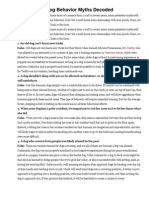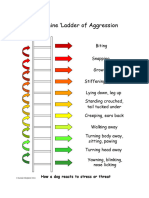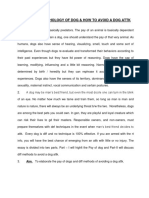Canine Aggression - Territorial
Canine Aggression - Territorial
Uploaded by
Brook Farm Veterinary CenterCopyright:
Available Formats
Canine Aggression - Territorial
Canine Aggression - Territorial
Uploaded by
Brook Farm Veterinary CenterOriginal Description:
Copyright
Available Formats
Share this document
Did you find this document useful?
Is this content inappropriate?
Copyright:
Available Formats
Canine Aggression - Territorial
Canine Aggression - Territorial
Uploaded by
Brook Farm Veterinary CenterCopyright:
Available Formats
CANINE AGGRESSION: TERRITORIAL AGGRESSION
What is territorial aggression and how can it be diagnosed?
Territorial or protective aggression may be exhibited toward people or other animals that approach the pets property. Generally people and other animals that are unusual, less familiar to the dog, or most unlike the members of the household are the most likely targets of territorial aggression. In other words something about the sight, sound or actions of the stimulus is causing an alerting, anxious or defensive response on the part of the dog. While most forms of territorial aggression are likely to occur on the property, some dogs may protect areas where they are temporarily housed and may protect family members regardless of the location. Territorial aggressive displays may vary, ranging from growling and barking to lunging, chasing, snapping and biting. Territorial displays may occur at windows, doors, behind fences and in the car. Some dogs may quickly claim territory and show similar behaviors at picnic areas, park benches, etc. Dogs that are physically prevented by a barricade or leash from gaining access to the stimulus (frustration) may have their aggression heightened or may develop displacement behaviors (e.g. spinning, circling, self mutilation) or redirected behaviors (e.g. turning their aggression on the owner who attempts to reach for or grab the dog. Many dogs continue their aggression once the person has entered the territory or home, which could result in biting and severe injury. In some cases due to the high arousal level of the dog, an element of frustration may also be present and can lead to redirected behavior toward objects or other animals or people.
How can territorial aggression be prevented?
Territorial aggression can be prevented or minimized with early socialization and good control. Young dogs should be taught to sit and receive a reward as each new person comes to the door. To reduce potential fear and anxiety toward visitors, you should ensure that a wide variety of visitors come over to visit the puppy while the puppy is young and sociable (see our handout on Socializing your new puppy). In time, most dogs will begin to alert the family by barking when strangers come to the home. However the dog that has been well socialized and under good control can be trained to quickly settle down and relax.
Why are territorial behaviors ongoing and perhaps even increasing?
For many dogs territorial displays are a normal part of their behavioral repertoire. While any dog may show territorial responses, certain breeds of dogs have been bred for guarding and watchful behaviors. Without appropriate supervision, owner interaction and training of appropriate responses these dogs may engage in territorial displays that vary in intensity from mild barking to intense displays that might include growling, snarling, lunging, piloerection and even biting a person or animal entering the territory. Opportunity and environmental access to the stimulus will influence whether the behavior will take place. Without proper owner supervision and training, these behaviors may become excessive. Dogs that are tied may show extreme territorial behaviors and aggressive responses. Dogs that are left outside all day without owner supervision are also at risk for escalating territorial responses. Many dogs that show territorial responses are often fearful and anxious and just want the intruder to leave. The longer the person stays within the territory, the more aggressively aroused the dog may become. The goal of the territorial display is to get the intruder to leave. The longer the stimulus remains in place within sight or hearing of the pet, while the pet is frustrated from chasing the stimulus away because it is tied, penned or behind closed windows or doors, the greater the anxiety. Although dogs with mild fears might habituate with continued exposure, dogs that are constantly exposed (flooded) by an anxiety-evoking stimulus will have their fear heightened until the stimulus leaves. The removal (retreat) of the individual then further reinforces the strength of the response.
How can I treat territorial aggression?
For dogs exhibiting territorial aggression, you will need to gain enough control to have your dog sit, stay and when calmed down, take a reward at the front door. Generally a leash and head collar will give the fastest and most effective control. Teaching the dog to settle on command near the vicinity of the front door is an essential first step (See handout on settling your dog). If the dog cannot do that, then they should be removed from the area prior to admitting people into the home. Providing safety for individuals who must come to the home is essential. If the dog is showing territorial aggressive responses to visitors it should be removed and securely confined when company is present to avoid injury. If redirected behavior is a component of the initial problem it may be necessary to separate dogs to prevent fighting and injury if the problem dog encounters the stimulus. Owners should not reach for the dog when he is aggressively aroused to avoid injuries to them. If barking precedes the aggression you might be able to stop the sequence of events and train the dog to settle with products that inhibit barking such as the bark activated citronella collar or a hand held alarm (see below). However, you must be present to immediately reinforce the quiet and settled behavior with a favored treat or reward. Another essential first step is to no longer allow territorial aggressive displays to continue. An effort should be made to prevent ongoing territorial displays either at windows or along fence lines. This might mean blocking visual access out windows by covering them up or preventing the dog from getting to them, and not allowing outdoor access unless the dog is wearing a leash and head collar and is actively supervised by an adult who is holding onto the dogs leash. Punishment must be stopped since punishment tends to increase rather than decrease the anxiety and fear that may be underlying the behavior.
Once your dog can settle on command, more detailed training can occur. All the stimuli that provoke the territorial response should be identified and a response gradient determined; i.e. at what distance is the territorial response noted and how does the response vary with changing distance (approaching and retreating)? Using a desensitization and counter-conditioning program (See our handout on counter-conditioning and desensitization) you can begin retraining with low levels of stimuli (such as people arriving in a car, walking past the front of the house, or perhaps even a family member knocking on the door or ringing the bell). The idea is that each time someone arrives at the house or rings the bell, the dog will come to expect a favored reward (toy, cheese, hot dog slice or play session). Once the dog can be controlled and receives rewards in this environment, gradually more intense stimuli can be used.
A big part of my dogs problem is barking. How can I control that?
Some dogs confine their territorial display to barking and nothing else. Teaching the dog to reliably respond to a command that signals quiet is essential. In some cases an anti-bark collar, bark activated alarm or a shaker can or audible device that is activated by the owner will disrupt the barking (at least temporarily). In this interval where the dog is quiet you must reinforce the quiet behavior with a favored treat or toy. Over time gradually increase the quiet time before the reward is given and provide multiple rewards if the dog does not bark at all. With some other dogs it may be more difficult to control barking, so please see our handouts on barking and management devices for additional treatment methods.
This client information sheet is based on material written by Debra Horwitz, DVM, Diplomate ACVB & Gary Landsberg, DVM, Diplomate ACVB Copyright 2005 Lifelearn Inc. Used with permission under license. December 28, 2011
You might also like
- Dopamine NationDocument1 pageDopamine NationIntrovert100% (2)
- Book Summary: Pitch Anything by Oren KlaffDocument20 pagesBook Summary: Pitch Anything by Oren Klaffamasino1100% (3)
- Dog Body LanguageDocument3 pagesDog Body LanguageClay Connor100% (1)
- Drives by Gary PattersonDocument6 pagesDrives by Gary Pattersonapi-2083465420% (1)
- Dog Behavior Disorders PDFDocument188 pagesDog Behavior Disorders PDFHOURRI Mly Mustapha100% (2)
- Retreat 'N Treat PDFDocument3 pagesRetreat 'N Treat PDFUri GrunNo ratings yet
- What To Text A Girl A PrimerDocument55 pagesWhat To Text A Girl A Primermail400365% (20)
- Donald Hilton Address PornographyDocument24 pagesDonald Hilton Address Pornographyda5idnzNo ratings yet
- 10 Common Dog Behavior Problems and SolutionsDocument14 pages10 Common Dog Behavior Problems and SolutionsFeby Yolanda Wulandari100% (3)
- Feline Vocalization - Excessive: Why Is My Cat Persistently Crying?Document4 pagesFeline Vocalization - Excessive: Why Is My Cat Persistently Crying?Brook Farm Veterinary CenterNo ratings yet
- Chapter 1 - Recognizing AggressionDocument8 pagesChapter 1 - Recognizing AggressionPerritoNo ratings yet
- Feline Friendly Handling GuidelinesDocument14 pagesFeline Friendly Handling GuidelinesBrendan Olof Boostrom100% (1)
- GENTLE HANDS OFF DOG TRAINING: DOGWISE SOLUTIONSFrom EverandGENTLE HANDS OFF DOG TRAINING: DOGWISE SOLUTIONSRating: 4 out of 5 stars4/5 (7)
- Breed Differences in Canine AggressionDocument20 pagesBreed Differences in Canine AggressionJD46No ratings yet
- Dog Aggression - Is It Predictable? How Do Humans' Contribute To Dog Aggression? Are We Responsible? Part OneDocument8 pagesDog Aggression - Is It Predictable? How Do Humans' Contribute To Dog Aggression? Are We Responsible? Part Onejoyce kesling, cdbcNo ratings yet
- Fear in DogsDocument8 pagesFear in DogsNevaeh Valli DeevaNo ratings yet
- Classical and Operant ConditioningDocument7 pagesClassical and Operant ConditioningABNo ratings yet
- CANINE-Canine Behavior ProblemsDocument7 pagesCANINE-Canine Behavior Problemstaner_soysurenNo ratings yet
- 14 Common Dog Behavior Myths DecodedDocument8 pages14 Common Dog Behavior Myths DecodedIsaac JohnNo ratings yet
- Top 10 Tips: For Taking Care of Your PetsDocument27 pagesTop 10 Tips: For Taking Care of Your PetsclarenceNo ratings yet
- Fearful Dogs 101: Give Them Space But Not Too Much!Document2 pagesFearful Dogs 101: Give Them Space But Not Too Much!JamieNo ratings yet
- Treatments Affecting Dog BehaviorDocument3 pagesTreatments Affecting Dog BehaviorLuis Buitrón RamírezNo ratings yet
- Separation, Confinement, or Noises:: What Is Scaring That Dog?Document20 pagesSeparation, Confinement, or Noises:: What Is Scaring That Dog?Luis Antonio Buitron Ramirez100% (1)
- Animal Behavior Consulting: Theory and Practice: Fall 2006Document41 pagesAnimal Behavior Consulting: Theory and Practice: Fall 2006iaabc100% (1)
- Serpell Purdue CanineDocument40 pagesSerpell Purdue CanineLuis Buitrón Ramírez100% (1)
- Canine WorkbookDocument48 pagesCanine Workbookrosy_verenice100% (1)
- Compulsive Behavior in Companion AnimalsDocument6 pagesCompulsive Behavior in Companion AnimalsJulio César Hernández PinedaNo ratings yet
- Puppy - Handling Food Bowl ExcerisesDocument6 pagesPuppy - Handling Food Bowl ExcerisesBrook Farm Veterinary CenterNo ratings yet
- Protocol For Deference Karen Overall 2012Document15 pagesProtocol For Deference Karen Overall 2012Sean Carlo CastilloNo ratings yet
- Canine Body LanguageDocument4 pagesCanine Body LanguageAB0% (1)
- Human-Directed Dog AggressionDocument184 pagesHuman-Directed Dog AggressionTanya Vane Way100% (1)
- Welfare in Dog TrainingDocument13 pagesWelfare in Dog TrainingNicholay AtanassovNo ratings yet
- Critical Periods in A Puppy LifeDocument7 pagesCritical Periods in A Puppy Lifeapi-208346542No ratings yet
- Canine Life Stage GuidelinesDocument11 pagesCanine Life Stage GuidelinesmlantzmanNo ratings yet
- 300 PeckDocument3 pages300 PeckFlorentina IrimiaNo ratings yet
- Animal Behavior Consulting: Theory and Practice: Spring 2008Document36 pagesAnimal Behavior Consulting: Theory and Practice: Spring 2008iaabc100% (1)
- Dog Obedience Training Tips For Dog Club MembersDocument3 pagesDog Obedience Training Tips For Dog Club MembersShoshannah ForbesNo ratings yet
- Volhard Puppy Aptitude TestDocument6 pagesVolhard Puppy Aptitude Testcyberlove160027009100% (1)
- Canine Body Language A Photographic GuidDocument7 pagesCanine Body Language A Photographic GuidLaura SánchezNo ratings yet
- Module 16: Training Dogs - More On How Dogs LearnDocument11 pagesModule 16: Training Dogs - More On How Dogs LearnOana DumbravaNo ratings yet
- Howto Cure Separation AnxietyDocument27 pagesHowto Cure Separation AnxietyAli Khader Abbas100% (2)
- The Tellington Ttouch Method: Supportive Care For Senior DogsDocument3 pagesThe Tellington Ttouch Method: Supportive Care For Senior DogsCecilio Gutierrez100% (1)
- Written by Jennifer Warner Edited by Abbie Moore Chapter 14 Written by Katya FreedmanDocument21 pagesWritten by Jennifer Warner Edited by Abbie Moore Chapter 14 Written by Katya Freedmanzatanna10No ratings yet
- Pharmacotherapeutics in Clinical Ethology: Treatment Efficacy, Clinical Pathology and OutcomeDocument65 pagesPharmacotherapeutics in Clinical Ethology: Treatment Efficacy, Clinical Pathology and OutcomeLuis Buitrón RamírezNo ratings yet
- Canine Ladder of AggressionDocument2 pagesCanine Ladder of AggressionTsvetomiraNo ratings yet
- Teaching Dogs To Settle HorwitzDocument2 pagesTeaching Dogs To Settle HorwitzfrancesjadeNo ratings yet
- Anxiety Disorders in DogsDocument22 pagesAnxiety Disorders in DogsAnonymous TDI8qdYNo ratings yet
- Psych of DogDocument14 pagesPsych of DogIntizar RaoNo ratings yet
- The Ligaments of The Canine Hip Joint RevisitedDocument8 pagesThe Ligaments of The Canine Hip Joint RevisitedrockyNo ratings yet
- Animal Behavior: Collective Behavior of AnimalsDocument1 pageAnimal Behavior: Collective Behavior of AnimalsSebas RodriguezNo ratings yet
- Aggressive Behaviors in Domestic CatsDocument8 pagesAggressive Behaviors in Domestic CatsElida LiraNo ratings yet
- Pregnant Dog - Pregnancy Signs in Dogs - Dog Article On Pets - Ca What To Expect When Your Dog Is ExpectingDocument3 pagesPregnant Dog - Pregnancy Signs in Dogs - Dog Article On Pets - Ca What To Expect When Your Dog Is Expectingmale nurseNo ratings yet
- Don T Screw Up Your DogDocument69 pagesDon T Screw Up Your Dogzvezdica72No ratings yet
- Association Between Puppy Classes and Adulthood Behavior of The DogDocument24 pagesAssociation Between Puppy Classes and Adulthood Behavior of The Dogsusey madelit apaza mamaniNo ratings yet
- Secret To Dog TrainingDocument17 pagesSecret To Dog Trainingvineet094No ratings yet
- Ebook - Aversive Training Methods and Papers Ver1Document318 pagesEbook - Aversive Training Methods and Papers Ver1caninebehaviorexpert100% (1)
- Professional Kennel Operator Diploma Module-1Document19 pagesProfessional Kennel Operator Diploma Module-1spencerjones7525No ratings yet
- Animal Behavior Consulting: Theory and Practice: Spring 2007Document60 pagesAnimal Behavior Consulting: Theory and Practice: Spring 2007iaabc100% (3)
- Bark No More PlaybookDocument21 pagesBark No More Playbookgloves.car0t100% (2)
- Canine Handling and SOFT ExercisesDocument3 pagesCanine Handling and SOFT ExercisesBrook Farm Veterinary Center100% (1)
- Poodle Color GeneticsDocument10 pagesPoodle Color GeneticsGerardo Martell MartínezNo ratings yet
- Pet Selection - GuidelinesDocument5 pagesPet Selection - GuidelinesBrook Farm Veterinary CenterNo ratings yet
- Reinforcement - Learning and RewardsDocument5 pagesReinforcement - Learning and RewardsBrook Farm Veterinary CenterNo ratings yet
- Puppy - Handling Food Bowl ExcerisesDocument6 pagesPuppy - Handling Food Bowl ExcerisesBrook Farm Veterinary CenterNo ratings yet
- Kitten - Introducing To A New HomeDocument5 pagesKitten - Introducing To A New HomeBrook Farm Veterinary CenterNo ratings yet
- Controlling Undesirable Behavior in Cats: When Is A Physical Reprimand Acceptable?Document4 pagesControlling Undesirable Behavior in Cats: When Is A Physical Reprimand Acceptable?Brook Farm Veterinary CenterNo ratings yet
- Feline Scratching: Why Do Cats Scratch?Document5 pagesFeline Scratching: Why Do Cats Scratch?Brook Farm Veterinary CenterNo ratings yet
- Feline FearsDocument4 pagesFeline FearsBrook Farm Veterinary CenterNo ratings yet
- Feline Aggression - RedirectedDocument4 pagesFeline Aggression - RedirectedBrook Farm Veterinary CenterNo ratings yet
- Compulsive Stereotypic and Displacement DisordersDocument5 pagesCompulsive Stereotypic and Displacement DisordersBrook Farm Veterinary CenterNo ratings yet
- Feline - The Multi-Cat HouseholdDocument4 pagesFeline - The Multi-Cat HouseholdBrook Farm Veterinary CenterNo ratings yet
- Fears Phobias and AnxietyDocument4 pagesFears Phobias and AnxietyBrook Farm Veterinary CenterNo ratings yet
- Canine Training Control ProductsDocument5 pagesCanine Training Control ProductsBrook Farm Veterinary CenterNo ratings yet
- Dislocation Theory of AddictionDocument37 pagesDislocation Theory of AddictionAlguém100% (1)
- The 100-Year Life - How To Make Longevity A Blessing, Not A Curse - New ScientistDocument3 pagesThe 100-Year Life - How To Make Longevity A Blessing, Not A Curse - New ScientistSilvana BorgesNo ratings yet
- Samuel's Critical Literature ReviewDocument11 pagesSamuel's Critical Literature ReviewIgor Dos SantosNo ratings yet
- Baumrind 1966 PDFDocument22 pagesBaumrind 1966 PDFcalmeida_31No ratings yet
- Higher FunctionDocument181 pagesHigher FunctionMeilisa OngNo ratings yet
- Malmo 1942Document14 pagesMalmo 1942Víctor FuentesNo ratings yet
- 3 Brain Hacks in 2 Mins To Improve Your Study Sessions Way BetterDocument12 pages3 Brain Hacks in 2 Mins To Improve Your Study Sessions Way BetterashishmstudyNo ratings yet
- TarangDocument20 pagesTarangAnonymous 5quBUnmvm1No ratings yet
- The Porn Circuit - Covenant Eye - DesconocidoDocument47 pagesThe Porn Circuit - Covenant Eye - DesconocidoirvmacNo ratings yet
- The Motivational Basis Organizational Behavior: IlanielDocument16 pagesThe Motivational Basis Organizational Behavior: IlanielShahid RashidNo ratings yet
- Methamphetamine Research ReportDocument22 pagesMethamphetamine Research ReportHasheem AliNo ratings yet
- Theory X and Theory Y NewDocument10 pagesTheory X and Theory Y Newmustaf mohamedNo ratings yet
- 5117 Campoy Chapter 5 PDFDocument38 pages5117 Campoy Chapter 5 PDFIbrahim ShakirNo ratings yet
- Studies Psychology Summary Edexcel GCEDocument30 pagesStudies Psychology Summary Edexcel GCEmiraNo ratings yet
- Emotion and Decision Making: Multiple Modulatory Neural CircuitsDocument28 pagesEmotion and Decision Making: Multiple Modulatory Neural CircuitsajayNo ratings yet
- A Review of Torque Release Technique®Document5 pagesA Review of Torque Release Technique®Ed RibeiroNo ratings yet
- Addiction Recovery ManagementDocument71 pagesAddiction Recovery ManagementThe Stacie Mathewson FoundationNo ratings yet
- 4 Ways Porn Kills Great Sex in MarriageDocument12 pages4 Ways Porn Kills Great Sex in MarriagepalapyeNo ratings yet
- The Organ of TactilityDocument60 pagesThe Organ of TactilityAbhinav JhadeNo ratings yet
- Social Media AddictionDocument7 pagesSocial Media AddictionNisa ShaqiriNo ratings yet
- The Learning Motivations of Paulinian Senior High School Students Spititual CommitteeDocument71 pagesThe Learning Motivations of Paulinian Senior High School Students Spititual CommitteeLeah PascualNo ratings yet
- Sueño y AdiccionesDocument11 pagesSueño y AdiccionesJOSE GARCIA PINTEÑONo ratings yet
- 5691 17779 1 PBDocument9 pages5691 17779 1 PBDmdm00No ratings yet
- Bringing The Full Power of Science To Bear On: Drug Abuse & AddictionDocument75 pagesBringing The Full Power of Science To Bear On: Drug Abuse & Addictionmlulu100% (1)
- Anhedonia Preclinical, Translational, and Clinical Integration (Ch. 1)Document30 pagesAnhedonia Preclinical, Translational, and Clinical Integration (Ch. 1)strillenNo ratings yet
- Chad Breitenfeldt - Inside Out Film Analysis - 1591555Document3 pagesChad Breitenfeldt - Inside Out Film Analysis - 1591555api-538816472No ratings yet




































































































